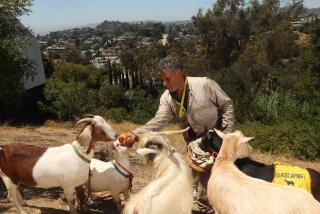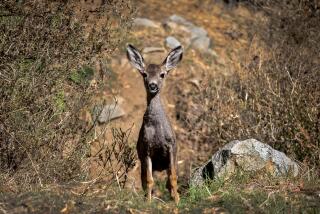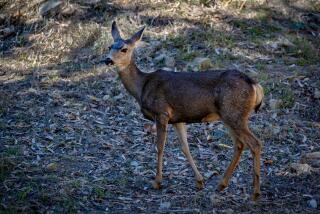Catalina Goat Hunt Ends; 2,000 Killed : Ecology: Sharpshooters meet extermination goal a month early. Protesters continue to assail ‘cruel’ tactic to protect island’s plants and wildlife.
- Share via
A hunt aimed at eliminating wild goats from the west end of Santa Catalina Island has been called off a month ahead of schedule because enough goats have been killed to accomplish the goal of protecting the island’s native ecology, officials said Wednesday.
A team of four hunters hired by the Santa Catalina Island Conservancy stopped shooting Tuesday, after killing an estimated 2,000 goats in two weeks.
While as many as 500 of the goats remain, the population has been reduced enough so that native grasses, shrubs and animals--such as the island fox--will be able to thrive, conservancy spokeswoman Penelope O’Malley said.
Animal rights activists said Wednesday they are angry that the conservancy, which owns 86% of the island, did not give them a chance to save the goats by trapping them and removing them from the island.
“Isn’t it outrageous?” asked Cleveland Amory, founder and president of the Fund for Animals. “They run this island as if they’ve owned it forever, and they visit this kind of unnecessary cruelty on goats, which are much more worthy inhabitants of the island than they’ll ever be.”
In the mid-1980s, the Fund for Animals intervened in a similar conflict on San Clemente Island, trapping and moving to mainland ranches about 3,300 goats that Navy sharpshooters were about to kill--also to preserve natural vegetation.
But the animal rights group and officials at the conservancy, which works to preserve Catalina’s native plants and animals, disagreed on whether trapping would work on the island. Conservancy officials said Catalina was too rugged and that the wild animals would die of stress in captivity anyway. Amory said terrain was rougher on San Clemente, where the alternative had worked, and that most of the goats from that island survived in captivity.
O’Malley called the goat hunt an unfortunate necessity, triggered by the uncontrolled proliferation of domestic goats brought to the island in the 1800s by Spanish missionaries. The goats stripped much of the island of vegetation, leaving nothing to hold topsoil in place and “killing the land,” she said.
On Jan. 15, four hunters began shooting goats with high-powered rifles. Biologist David Garcelon, who led the hunt, had estimated it would take until the end of this month to kill off the goats. But the hunters decided to stop Tuesday because most of the west end of the island had been cleared, O’Malley said.
More to Read
Sign up for Essential California
The most important California stories and recommendations in your inbox every morning.
You may occasionally receive promotional content from the Los Angeles Times.











